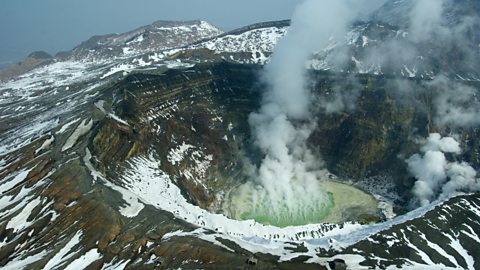Volcano locations
Volcanoes form when magmaMolten rock that is found within the Earth., which is molten rock from beneath the Earth's crust, reaches the surface. The magma erupts to form lavaMolten rock that is released from the Earth's core in a volcano or fissure. .
Volcanoes usually form along plate boundaryThe region where two or more tectonic plates meet. It is a zone of intense seismic activity., where tectonic plates are either moving towards or away from one another:
- divergent plate boundaryAn area where two tectonic plates are moving away from one another. (or constructive boundary) - this is where two plates move away from one another. Magma rises up to fill the gaps between the plates usually to create a shield volcanoA volcano with gentle slopes that was made by runny, less explosive basic lava..
- convergent plate boundaryWhen two tectonic plates move towards each other and collide. (specifically destructive) - this is where two plates move towards one another. The oceanic crust sinks beneath the continental crust at a subductionWhen one crustal plate is forced beneath the other. zone - a point where the more dense oceanic plate is forced beneath the less dense, continental plate. As the oceanic crust sinks into the mantle, it melts and creates magma and increases pressure. This magma rises to form explosive composite volcanoes (also known as stratovolcanoA volcano made up of alternate layers of ash and lava.).
Volcanoes affect different places in different ways. They cause more damage in poorer countries, where there are fewer resources to predict and prepare for them.

Mount Aso in Japan is one of the world's most active volcanoes